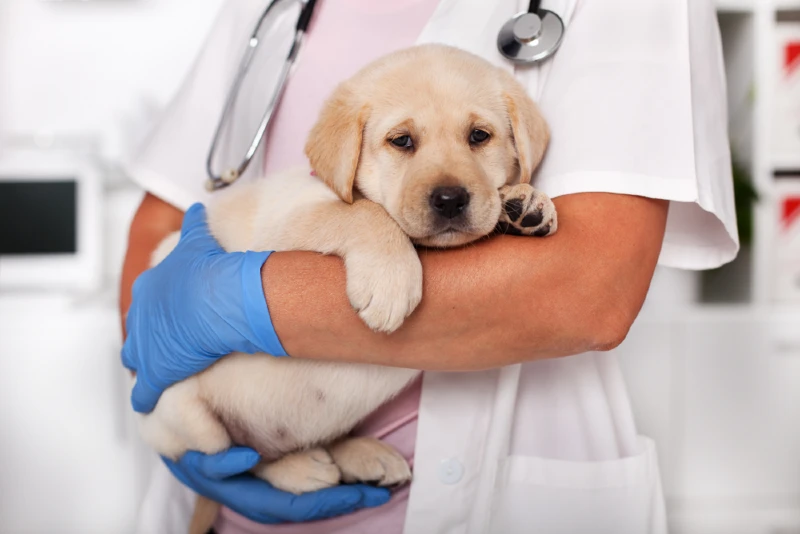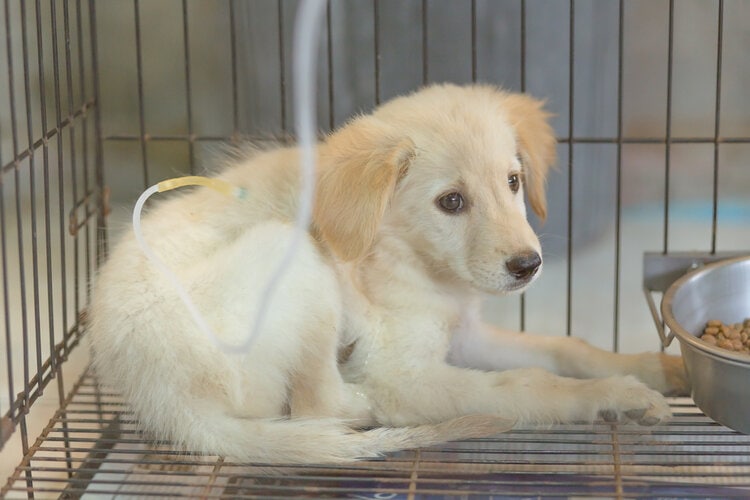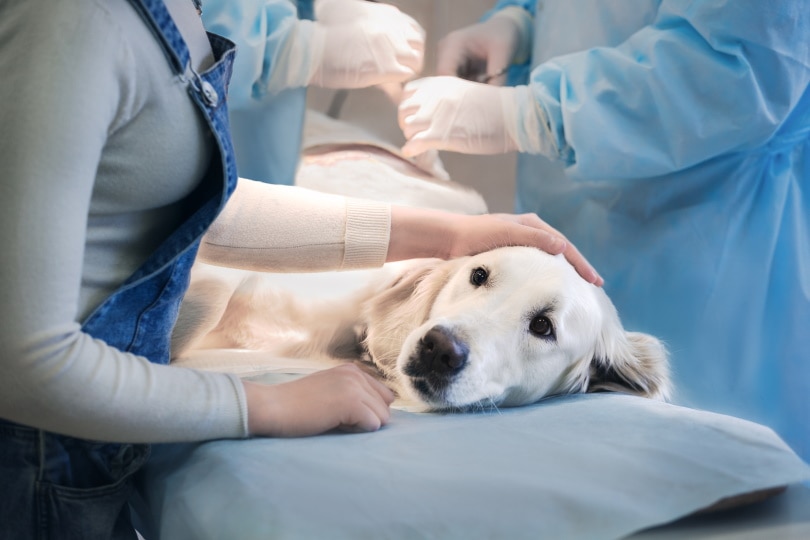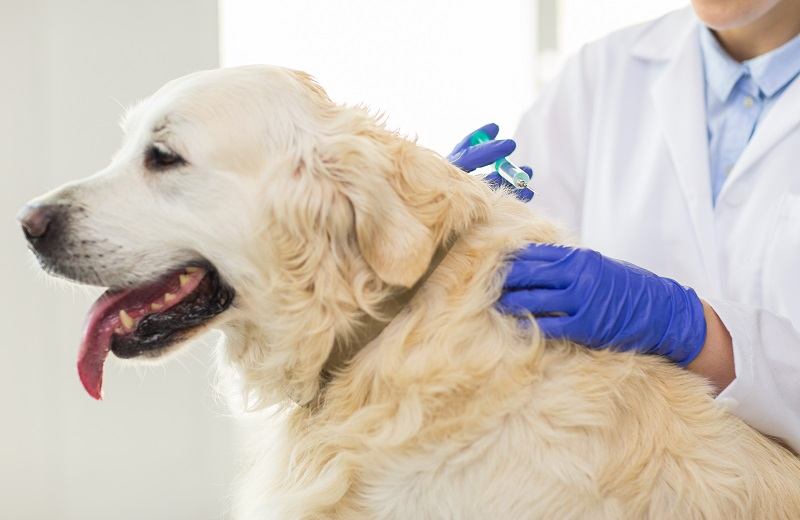
When you take your new puppy or adult dog to the vet for their shots, have you ever wondered about the diseases that the shots protect them from? Are they really serious enough to keep coming back for shots every year? When it comes to distemper or canine distemper virus, the answer is definitely yes. Distemper is a serious and highly contagious disease that can be fatal. But what exactly is distemper and how can it be treated? In this article, we discuss the causes, signs, and treatment of distemper, along with how to keep your dog from catching the disease.
What Is Distemper?

Canine distemper virus (CDV) is a viral disease caused by a paramyxovirus related to the virus that causes measles in humans.1 Distemper is a multi-systemic disease, meaning it spreads to and impacts multiple parts of a dog’s body.2 The distemper virus is found in dogs and ferrets, as well as many different species of wild animals, including raccoons, foxes, and otters.
A distemper infection typically happens in two stages: the mucosal phase and the neurologic phase.3 These phases refer to the systems of the body that are impacted during each stage. During the mucosal phase, the virus attacks the systems of the body that are lined with mucous membranes, like the respiratory tract and intestines. In the neurologic phase, the virus moves into the dog’s nervous system.
An infected dog will display different signs during each of these two phases. How sick a dog becomes during each phase depends on how well their immune systems respond to fight the virus. For this reason, unvaccinated puppies and older dogs with weak immune systems are most at risk from the distemper virus.
How Is Distemper Spread?
An infected animal can spread the virus to other animals in several different ways. The most common method is through aerosolized droplets, much like how humans spread the common cold or flu. Coughing releases infected droplets into the air and spreads them to nearby animals or shared surfaces.
Distemper can also spread through direct contact between an infected animal and others. The infected animal sheds the virus in their urine, feces, and nasal discharge. Other animals can come into contact with these and become infected.
Another way that distemper spreads is from a pregnant mother dog to her puppies in the uterus. The virus travels down the placenta from the mother to her pups, and they can become infected.
What Are the Signs of Distemper?
The Mucosal Phase

After a dog becomes infected with CDV, the virus first impacts the respiratory system before moving on to other systems like the gastrointestinal system. It usually takes a few days after a dog is infected for signs to begin. Common signs of this phase of canine distemper are as follows:
The dog’s immune system will go to work trying to fight off the virus during this phase. Some dogs get very sick, while others may only have mild signs. Severely sick dogs may not survive this phase of infection.
Another complication of distemper is that the dog’s immune system becomes so over-stressed that the dog is at risk of developing secondary infections. For example, some dogs with distemper will also develop pneumonia. These other infections can overwhelm the dog’s body, and they may not survive them.
Sometimes a dog will survive this phase and develop another sign called hyperkeratosis, or hardening of the paw pads and nose. This sign is why distemper is sometimes nicknamed, “hard pad disease.”
The Neurologic Phase

If a dog makes it through the first phase of distemper, they may seem to be fully recovered for a length of time, usually 1–3 weeks, but it could be as long as months. During this time, the virus may move into the dog’s nervous system, and the neurologic phase of distemper could begin. Signs of this phase of distemper include the following:
Not all dogs with distemper will move into the neurologic phase. There’s no good way to predict whether an infected dog will do so or not. Once they do develop neurologic signs, it is more difficult for them to recover from the disease. They may die from the disease itself or because they develop such severe signs that their quality of life is diminished, and their owners make the decision to put them to sleep. Dogs that do survive this phase may be left with lingering neurologic signs for the rest of their lives.
How Is Distemper Diagnosed and Treated?
Diagnosing Distemper
Treating distemper starts with correctly diagnosing the disease. The early signs of distemper are similar to many other diseases and conditions, which can make it hard for your vet to determine that your dog is infected with CDV.
A specific laboratory test called a polymerase chain reaction can be performed to diagnose distemper. If the dog has progressed to the neurologic phase, CDV is even harder to detect. Sometimes the dog will need to have a sample of spinal fluid taken and tested before a diagnosis is reached.

Treating Distemper
Technically, there is no specific treatment for the actual distemper disease. Your veterinarian will instead focus on treating individual signs and supporting your dog’s body as their immune system tries to fight the virus. They will also treat any other infections that may occur while your dog’s immune system is weakened by the fight.
Since there can be such a difference in how sick individual dogs may get from distemper, the treatment required varies widely. All infected dogs should be immediately isolated from any other dogs to prevent the spread of infection.
Very sick dogs will need to be hospitalized for monitoring, intravenous fluids and medication, and more intensive care. During the mucosal phase, dogs will often need antibiotics to fight infection or medications to treat diarrhea and vomiting. If the neurologic phase occurs, dogs may need to be treated with anti-seizure medications.
Unfortunately, even with treatment, distemper is often a fatal disease. Puppies in particular are at high risk of succumbing to CDV. Even if a dog survives distemper, they may suffer permanent neurologic damage. A distemper survivor may also continue to shed the virus for as long as 2–3 months, so they should be kept away from other dogs, especially unvaccinated dogs, during this time. Fortunately, once outside the dog’s body, the distemper virus doesn’t live long and can be killed off by most disinfectant cleaning products.
How to Keep Your Dog From Getting Distemper

If you’re thinking that distemper sounds like a horrible disease that you absolutely don’t want your dog to have, there is good news! Keeping up with your dog’s needed shots is a highly effective method to prevent distemper infection. In fact, they are so effective and their use is so widespread that distemper is now rarely seen except in shelters or rescues.
The absolute best way to keep your dog from getting distemper is to make sure they get all their shots on time and again whenever they are due. Puppies will need to get multiple doses of the distemper vaccine several weeks apart before they are fully protected. Until your puppy has gotten all their puppy shots, don’t let them interact with unfamiliar dogs in training classes, puppy daycare, or the dog park.
After your dog finishes their puppy shots, follow the advice of your veterinarian as far as how often your adult dog will need to receive a booster shot against distemper. Skipping booster shots can allow your dog to become vulnerable to distemper infection again. If you plan to breed your female dog, make sure she is properly vaccinated. This will protect her from disease and pass temporary immunity to her newborn pups when they first nurse.
- You may also be interested in: Ringworm in Dogs: Vet-Approved Signs, Treatment & Prevention
Final Thoughts
While distemper is a contagious, incurable, often fatal disease, most dogs and their owners will never have to suffer through it due to the existence of an effective vaccine. If you are concerned that your dog may be infected with distemper, the sooner supportive treatment can begin, the better. Contact your veterinarian as soon as possible. For this disease, remember that the most effective treatment is prevention, so make sure your dog always gets their shots.
Want to learn more about other dog diseases and ailments?
- Epilepsy in Dogs: Types, Symptoms, and Info
- Canine Degenerative Myelopathy in Dogs: Signs and Treatment
Featured image credit: Javier Brosch, Shutterstock







